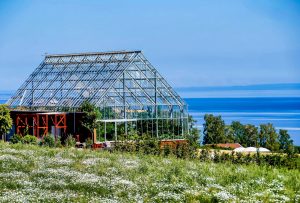Not sure What Is A Gothic Arch Greenhouse Used For? Well, A Gothic arch greenhouse is utilized for extended growing seasons, optimal temperature control, efficient space utilization, diverse plant cultivation, and aesthetic landscaping, serving as a versatile structure for horticulture, floriculture, and botanical displays as it features a tall and rounded peak.

The Gothic Arch Greenhouse stands as an iconic structure in gardening and horticulture, seamlessly blending form and function.
But what exactly is a Gothic Arch Greenhouse used for?
In this comprehensive guide, From nurturing plants to embracing sustainability, let’s explore 10 uses of a gothic arch greenhouse.
Also Check: Is Corrugated Plastic Good For A Greenhouse?
What Is A Gothic Arch Greenhouse Used For? 10 Best Uses
1. Gothic Arch Greenhouse Used To Enhance Year-Round Cultivation
One of the most compelling aspects of the Gothic Arch Greenhouse is its ability to extend the growing season. Year-round cultivation is one of the primary uses or reasons why a Gothic arch greenhouse is employed in agricultural and horticultural practices.
The Gothic arch design of the greenhouse structure is particularly well-suited for maximizing sunlight exposure and maintaining optimal growing conditions throughout the year. Here are several reasons why a Gothic arch greenhouse is effective for year-round cultivation:
Optimal Light Distribution: The curved shape of the Gothic arch allows sunlight to penetrate at various angles throughout the day and across seasons. This design helps to optimize light distribution within the greenhouse, ensuring that plants receive sufficient sunlight for photosynthesis.
Temperature Regulation: The shape of the Gothic arch greenhouse promotes efficient air circulation. The warm air rises to the peak of the arch, and the structure allows for easy ventilation, preventing overheating during hot periods. Additionally, the greenhouse retains heat well, providing a more stable temperature environment for plants during colder seasons.
Snow Shedding: The curved design of the Gothic arch allows snow to slide off the roof, preventing the accumulation of heavy snow loads. This feature is particularly important in colder climates where snowfall could otherwise damage or collapse traditional greenhouse structures.
Versatility: Gothic arch greenhouses come in various sizes and can be customized to fit different needs. This versatility makes them suitable for a wide range of crops and allows for efficient use of space.
Cost-Effectiveness: The design of the Gothic arch greenhouse often involves a simple and cost-effective structure compared to some other greenhouse types. This makes it an attractive option for farmers and gardeners looking to establish a greenhouse for year-round cultivation without breaking the bank.
Durability: The shape of the Gothic arch provides inherent strength to the structure, making it resistant to wind and other environmental stressors. This durability ensures that the greenhouse can withstand weather conditions and continue supporting year-round cultivation.
Pros:
- Continuous Growth
- Optimal Conditions
- Extended Seasons
- Year-Round Harvest
- Increased Yields
- Crop Variety
- Energy Efficiency
Cons:
- Initial Cost
- Maintenance Needs
- Space Constraints
2. Gothic Arch Greenhouse Enhances Optimal Temperature Control
The term “Gothic Arch Greenhouse” refers to a specific architectural design commonly used in greenhouse construction. The Gothic arch shape is characterized by its tall and rounded peak, resembling the arches seen in Gothic architecture. The Gothic arch shape allows for efficient temperature control in the greenhouse for a few reasons:
Natural Ventilation: The high, curved structure of the Gothic arch promotes natural ventilation. Hot air tends to rise, and the arch shape allows it to accumulate at the peak of the structure. This warm air can then be easily vented out through the sides or roof vents, promoting air circulation and preventing overheating.
Better Light Distribution: The shape of the greenhouse maximizes exposure to sunlight throughout the day. The high center allows sunlight to penetrate more directly, reaching plants at various angles as the sun moves across the sky. This helps in maintaining a more consistent temperature throughout the greenhouse.
Snow Shedding: The Gothic arch design is also effective in shedding snow. The rounded shape prevents snow accumulation on the roof, reducing the risk of structural damage and ensuring that sunlight can continue to reach plants even during winter months.
Uniform Heating: The arch shape allows for more uniform heating of the greenhouse space. The curved structure minimizes heat loss at the sides, helping to create a more stable and evenly distributed temperature inside.
Pros:
- Energy efficiency
- Precise climate control
- Optimal plant growth
- Year-round cultivation
- Reduced heating costs
- Pest control benefits
- Enhanced yield quality
Cons:
- Initial cost
- Maintenance expenses
- Limited space options
LFSYS Fruit Fly Traps for Indoors (1 Device+10 Refills) Plug in Fly Trap for Gnats, Fruit Flies, Flying Insects Sleek Design Indoor Safe
$9.99 (as of December 24, 2025 21:47 GMT +00:00 - More infoProduct prices and availability are accurate as of the date/time indicated and are subject to change. Any price and availability information displayed on [relevant Amazon Site(s), as applicable] at the time of purchase will apply to the purchase of this product.)Advion Cockroach Gel Bait, 4 Tubes x 30-Grams, 1 Plunger and 2 Tips, German Roach Insect Pest Control, Indoor and Outdoor Use, Roach Killer Gel for American, German and Other Major Cockroach Species
$24.16 (as of December 24, 2025 21:47 GMT +00:00 - More infoProduct prices and availability are accurate as of the date/time indicated and are subject to change. Any price and availability information displayed on [relevant Amazon Site(s), as applicable] at the time of purchase will apply to the purchase of this product.)21in BBQ Blanket for Resting Meat-Smoking Meat Insulated Bag for Brisket/Beef/Pork Shoulder/Turkey-White Elephant Christmas Stocking Stuffers Birthday Anniversary Smoker Accessories Gift for Men
$29.99 (as of December 25, 2025 23:02 GMT +00:00 - More infoProduct prices and availability are accurate as of the date/time indicated and are subject to change. Any price and availability information displayed on [relevant Amazon Site(s), as applicable] at the time of purchase will apply to the purchase of this product.)Anker SOLIX C1000 Gen 2 Portable Power Station with 100W Solar Panel, 2,000W (Peak 3,000W) Solar Generator, Full Charge in 49 Min, 1,024Wh LiFePO4 Battery for Home Backup, Power Outages, and Camping
$429.00 (as of December 24, 2025 21:47 GMT +00:00 - More infoProduct prices and availability are accurate as of the date/time indicated and are subject to change. Any price and availability information displayed on [relevant Amazon Site(s), as applicable] at the time of purchase will apply to the purchase of this product.)birdsnap® TUC Bird Feeder with Camera 2K HD, Solar Panel 32GB Card 4-in-1 Perch, 160°View Auto Detect & Notify AI Identify Video Bird Camera Wireless Outdoors Ideal Gift for Birds Lover
$59.99 (as of December 25, 2025 23:02 GMT +00:00 - More infoProduct prices and availability are accurate as of the date/time indicated and are subject to change. Any price and availability information displayed on [relevant Amazon Site(s), as applicable] at the time of purchase will apply to the purchase of this product.)- Gothic Arch Greenhouse Used Due Space Optimization Ability
Gothic Arch Greenhouses, with their elegant design, maximize space utilization. Height and Space Optimization: The Gothic arch design of a greenhouse maximizes vertical space, showcasing its commitment to Space Optimization.
This unique architectural approach allows for efficient use of space, providing more headroom for tall plants and demonstrating the benefits of A Gothic Arch Greenhouse.
Uniform Light Distribution in a Gothic Arch Greenhouse: The curved shape of A Gothic Arch Greenhouse optimally captures and distributes natural sunlight, exemplifying the commitment to Space Optimization.
This ensures that light is evenly spread throughout the greenhouse, promoting consistent growth and minimizing shading effects inherent in other designs.
Natural Ventilation and Space Optimization: The Gothic arch shape facilitates natural ventilation, showcasing the integration of Space Optimization principles.
This natural ventilation is crucial for preventing issues such as overheating, especially in warmer climates, and highlights the functionality of A Gothic Arch Greenhouse.
Snow Shedding for Space Optimization: The curved design of A Gothic Arch Greenhouse allows snow to slide off the roof easily, preventing the accumulation of heavy snow loads and exemplifying Space Optimization.
This characteristic is particularly advantageous in colder climates, reducing the risk of structural damage and ensuring the greenhouse remains functional throughout the year.
Cost-Effectiveness and Space Optimization: The Gothic arch design of A Gothic Arch Greenhouse often requires fewer materials, making it a cost-effective option that aligns with the principles of Space Optimization.
The simplicity of the structure contributes to more accessible and economical construction, further highlighting the commitment to Space Optimization.
Adaptability with Space Optimization: Gothic arch greenhouses, characterized by their adaptability to various sizes, showcase the scalability and Space Optimization principles.
A Gothic Arch Greenhouse can be easily extended by adding additional sections, making it suitable for different gardening needs, from small-scale hobbyists to larger commercial operations, and emphasizing the importance of Space Optimization in design.
Pros:
- Height Efficiency
- Uniform Light
- Natural Ventilation
- Snow Shedding
- Cost-Effective
- Adaptability
- Scalable Design
Cons:
- Limited Width
- Construction Complexity
- Wind Sensitivity
4. Gothic Arch Greenhouse Used Due Enhanced Light Distribution
The use of a Gothic arch design in greenhouses, often referred to as a Gothic arch greenhouse, offers several advantages, and enhanced light distribution is indeed one of the key reasons for its popularity.
The Gothic arch shape, characterized by its high center point and sloping sides, contributes to improved light penetration and distribution within the greenhouse. Here are some reasons why enhanced light distribution is important and how the Gothic arch design achieves it:
Optimal Sunlight Capture: The curved shape of the Gothic arch maximizes the exposure of the greenhouse to sunlight throughout the day. This design allows the structure to capture sunlight from various angles, especially during the low-angled sun periods in the morning and evening.
Uniform Light Distribution: The sloping sides of the Gothic arch help distribute sunlight more evenly across the entire greenhouse interior. This reduces shading and ensures that plants receive a more uniform amount of light, promoting consistent growth and development.
Extended Daylight Hours: The Gothic arch greenhouse can capture sunlight for a longer duration during the day due to its ability to receive sunlight at different angles. This extended exposure to natural light can positively impact the productivity of plants by providing them with more hours of photosynthesis.
Improved Light Diffusion: The curved shape of the greenhouse helps scatter and diffuse sunlight, preventing direct, intense sunlight from causing hotspots or uneven heating within the structure. This diffusion aids in creating a more controlled and favorable environment for plant growth.
Energy Efficiency: The design reduces the need for artificial lighting during daylight hours, making the Gothic arch greenhouse more energy-efficient. Harnessing natural sunlight effectively helps growers save on energy costs and contributes to sustainable and eco-friendly practices. 5. Gothic Arch Greenhouse Used Versatile Crop Selection
of delicate flowers to robust vegetables. The Gothic Arch Greenhouse accommodates various crops. A Gothic Arch Greenhouse is designed with a distinctive curved or pointed roof, resembling the shape of a gothic arch.
Moreover , This type of greenhouse structure is versatile and serves various purposes, one of which is facilitating versatile crop selection through optimal growing conditions. Here’s how the Gothic Arch Greenhouse contributes to this aspect:
Temperature Control: The gothic arch design allows for efficient temperature control within the greenhouse. The curved shape enhances heat retention, promoting a more stable and conducive environment for a variety of crops. This adaptability is crucial for accommodating the specific temperature requirements of different plants.
Ventilation: The arched structure also facilitates natural ventilation. The shape promotes air circulation, helping to prevent the buildup of excessive heat and humidity. This ventilation control is essential for creating suitable conditions for diverse crops with varying preferences regarding airflow.
Light Distribution: The curved roof design maximizes the penetration of natural sunlight. This feature is especially beneficial for plants with different light requirements. By allowing for optimal light distribution, the greenhouse supports the growth of a wide range of crops, each needing specific light levels for photosynthesis.
Space Utilization: The gothic arch shape provides a more efficient use of space compared to traditional greenhouse designs. This enables gardeners to cultivate a greater variety of crops within the available area. The adaptable space allows for experimentation with different plant types, creating a diverse and productive growing environment.
Adaptability to Various Crops: The controlled environment offered by a gothic arch greenhouse makes it suitable for growing a variety of crops, including fruits, vegetables, flowers, and herbs. Gardeners can tailor the conditions within the greenhouse to suit the specific needs of different plants, expanding the range of crops that can be successfully cultivated.
Pros:
- Optimal temperature control
- Efficient ventilation
- Maximized light distribution
- Space utilization
- Adaptability to crops
- Diverse cultivation
- Controlled environment
Cons:
- Costly construction
- Limited size options
- Maintenance challenges
- Gothic Arch Greenhouse Used Due To Durability and Stability
Crafted with durability in mind, Gothic Arch Greenhouses are often constructed with sturdy materials. Their robust design not only withstands the elements but also provides a stable environment for plants to thrive. This durability ensures a long-lasting investment for passionate gardeners.
Enhanced Durability and Stability: The Gothic Arch Greenhouse, with its distinctive curved roof, optimizes weight distribution along its arching structure, ensuring increased durability and stability when compared to conventional flat-roofed greenhouses.
The arch shape is engineered to withstand external forces like wind and snow load more effectively, enhancing the overall stability of the Gothic Arch Greenhouse.
Resilience in Harsh Weather Conditions: Specifically designed to resist snow accumulation, the Gothic Arch Greenhouse mitigates the risk of excessive weight on the roof, a critical feature for regions experiencing heavy snowfall.
Its aerodynamic profile minimizes wind resistance, reducing the likelihood of structural damage during storms, exemplifying the durability of the Gothic Arch Greenhouse.
Efficient Natural Debris Shedding: The Gothic Arch Greenhouse’s curved roof promotes the natural shedding of debris, such as leaves and branches, preventing the accumulation of weight over time. This characteristic contributes to the longevity and durability of the structure.
Expansive Interior Space for Increased Stability: The Gothic Arch Greenhouse’s arch design not only enhances durability but also provides a more spacious interior compared to traditional greenhouse structures. This additional space improves air circulation and plant growth, further emphasizing the stability of the greenhouse.
Uniform Light Distribution for Enhanced Stability: The Gothic Arch Greenhouse’s curved roof design facilitates efficient sunlight distribution, ensuring uniform light exposure to plants throughout the structure. This characteristic promotes healthy and consistent growth, reinforcing the stability of the greenhouse environment.
Effective Water Drainage for Long-Term Stability: Engineered with proper drainage in mind, the Gothic Arch Greenhouse’s arch shape facilitates efficient water drainage, preventing the pooling of water on the roof. This design element is essential for avoiding water damage and maintaining the long-term stability and durability of the Gothic Arch Greenhouse.
Pros:
- Arch Strength
- Even Weight
- Snow Resistance
- Wind Resilience
- Debris Shedding
- Spacious Interior
- Uniform Light
Cons:
- Limited Height
- Construction Complexity
- Costly Materials
- Gothic Arch Greenhouse Used To Offer Aesthetic Appeal
Beyond its practical advantages, the Gothic Arch Greenhouse adds a touch of elegance to any garden.
The aesthetic appeal of a Gothic arch greenhouse is one of the reasons for its use. The Gothic arch design is characterized by its graceful curves and pointed arches, which not only serve functional purposes but also contribute to the overall visual appeal of the structure.
Here’s why aesthetic appeal is a notable aspect:
Elegance and Charm: The Gothic arch design is often associated with a sense of elegance and charm. Its graceful lines and arches give the greenhouse a distinctive and aesthetically pleasing look. This can enhance the overall beauty of a garden or landscape where the greenhouse is situated.
Blending with Surroundings: The architectural style of a Gothic arch greenhouse can complement various outdoor environments. Its classic and timeless design allows it to blend well with both traditional and contemporary landscapes, adding to the overall visual harmony of the surroundings.
Visual Focal Point: A Gothic arch greenhouse can serve as a visual focal point within a garden or outdoor space. Its unique design can draw attention and create a sense of interest, making it a standout feature that enhances the overall aesthetics of the area.
Cultural and Historical Allure: The Gothic arch design has historical and cultural significance, often associated with Gothic architecture in churches and other structures. Incorporating this design into a greenhouse can evoke a sense of history and tradition, adding depth and character to the space.
Personal Enjoyment: The aesthetic appeal can provide personal enjoyment for individuals who own or use a Gothic arch greenhouse. Spending time in a visually pleasing environment can contribute to a sense of well-being and satisfaction, making the greenhouse a functional space and aesthetic delight.
Pros:
- Visual Charm
- Elegant Design
- Blends Well
- Focal Point
- Historical Allure
- Cultural Significance
- Personal Enjoyment
Cons:
- Limited Space
- Higher Cost
- Maintenance Intensive
- Gothic Arch Greenhouse Used Due To Customization Possibilities
Gothic Arch Greenhouses offer a canvas for creativity. Gardeners can customize these structures to meet their specific needs. The Gothic arch greenhouse is a particular greenhouse design that features a rounded or pointed arch shape.
It is often used for various agricultural and horticultural purposes, and one of the reasons for its popularity is its customization possibilities. Here’s why customization is a crucial aspect of Gothic arch greenhouses:
Adaptability to Different Crops: The Gothic arch design allows for a flexible and adjustable framework. This means that the dimensions and height of the greenhouse can be customized to suit the specific needs of different crops. Some plants may require more vertical space, while others may benefit from a wider layout.
Climate Control: Customization in terms of ventilation and temperature control is crucial for successful greenhouse operations. The Gothic arch design provides options for adjustable sidewalls and roof vents, allowing growers to customize the airflow and temperature within the greenhouse. This is especially important for creating optimal conditions for various plants.
Space Utilization: The Gothic arch shape maximizes interior space, making it an efficient choice for growers who want to make the most of their available area. Customizing the layout and arrangement of plants becomes easier, and growers can adapt the greenhouse to their specific cultivation needs.
Structural Strength: Customization also extends to the materials used in constructing the greenhouse. Growers can choose materials that are best suited for their climate and environmental conditions. This ensures the structural strength and durability of the greenhouse, contributing to its long-term functionality.
Aesthetic Considerations: The Gothic arch design is not only practical but can also be visually appealing. Customizing the aesthetics of the greenhouse can enhance its overall look and integrate it seamlessly into its surroundings. This can be important for both commercial operations and private growers who value the visual aspect of their greenhouse.
Ease of Expansion: As agricultural needs evolve, growers may want to expand their greenhouse operations. The Gothic arch design lends itself well to easy expansion. Customizing the size and layout of additional greenhouse structures allows for scalability and adaptability to changing cultivation requirements.
Pros:
- Adaptability
- Climate control
- Space utilization
- Structural strength
- Aesthetics
- Ease of expansion
Cons:
- Cost
- Complexity
- Limited height
- Gothic Arch Greenhouse Used Due Weather Resilience Capabilities
In regions prone to extreme weather conditions, the Gothic Arch Greenhouse proves its mettle. The arched design aids in shedding snow and withstanding strong winds, ensuring the safety of both the structure and the precious plants inside, even in the harshest climates. The Gothic arch design of the greenhouse provides several benefits for weather resilience:
Snow Shedding: The curved shape of the greenhouse helps in shedding snow more effectively than traditional flat-roofed structures. This prevents the accumulation of heavy snow loads on the roof, reducing the risk of structural damage.
Wind Resistance: The arched shape also makes the greenhouse more resistant to strong winds. The curvature allows wind to flow smoothly over the structure, reducing wind resistance and minimizing the risk of damage during storms.
Water Drainage: The arch shape facilitates efficient water drainage. Rainwater and other precipitation can easily run off the curved roof, preventing water accumulation that could lead to leaks or structural issues.
Strength and Stability: The arch design provides structural strength and stability. This is particularly important in regions with variable weather conditions, including heavy snowfall, strong winds, and other environmental challenges.
Uniform Light Distribution: The shape of the Gothic arch allows for better light distribution within the greenhouse. This benefits plant growth, as it ensures that sunlight reaches plants at various angles throughout the day.
Pros:
- Climate control
- Year-round growing
- Natural light
- Space efficiency
- Durability
- Aesthetics
- Improved yield
Cons:
- Initial cost
- Limited space
- Maintenance costs
- Gothic Arch Greenhouse Used For Educational Opportunities
These greenhouses aren’t just for seasoned gardeners; they also serve as educational tools. Schools, community gardens, and botanical institutions find value in Gothic Arch Greenhouses, providing a hands-on learning experience about plant cultivation and environmental sustainability.
A Gothic Arch Greenhouse provides a controlled environment for cultivating plants, which can be utilized for various educational purposes. Here are some reasons why educational opportunities are linked to Gothic Arch Greenhouses:
Botanical Studies: Gothic Arch Greenhouses offer a suitable setting for studying plant biology, growth patterns, and various plant species. This controlled environment allows students and researchers to observe and analyze plant development under different conditions.
Hands-On Learning: These greenhouses provide a hands-on learning experience for horticulture, agriculture, or environmental science students. Students can actively participate in planting, caring for, and studying plants, gaining practical skills in the process.
Research and Experiments: The controlled environment of a Gothic Arch Greenhouse allows for controlled experiments. Students and researchers can manipulate factors like temperature, humidity, and light to conduct experiments and research projects related to plant physiology, genetics, and environmental impacts.
Educational Programs: Educational institutions often use Gothic Arch Greenhouses as their curriculum. Courses related to plant science, agriculture, and environmental studies may include practical sessions in the greenhouse, enhancing the overall learning experience.
Community Education: Gothic Arch Greenhouses can serve as community resources for educational programs. Workshops, seminars, and outreach programs can be conducted to educate the local community about sustainable agriculture practices, gardening techniques, and the importance of plants in the ecosystem.
Culinary Education: Some Gothic Arch Greenhouses are used in culinary programs to grow specific plants or herbs. Students studying culinary arts can learn about sustainable sourcing of ingredients and gain hands-on experience in growing herbs and vegetables.
Environmental Awareness: Gothic Arch Greenhouses provide a platform to raise awareness about environmental issues, such as the importance of sustainable agriculture, the impact of climate change on plants, and the role of plants in maintaining ecological balance.
Pros:
- Controlled Environment
- Botanical Studies
- Hands-On Learning
- Research Experiments
- Educational Programs
- Community Education
- Culinary Education
Cons:
- Initial Cost
- Maintenance Required
- Limited Space
Conclusion
In summary, the Gothic Arch Greenhouse proves itself to be a vital asset in agriculture, seamlessly combining functionality with visual appeal.
Moreover, the Gothic Arch Greenhouse adaptable structure extends growing seasons, regulates temperatures efficiently, and maximizes space, making it indispensable for farmers, commercial cultivators, and botanical institutions.
Beyond its practicality, Gothic Arch Greenhouse symbolizes a commitment to sustainable farming practices, promoting eco-friendly growing techniques.
Whether nurturing a diverse range of crops or creating aesthetically pleasing landscapes, the Gothic Arch Greenhouse serves as a dynamic hub for agricultural innovation and creativity.




